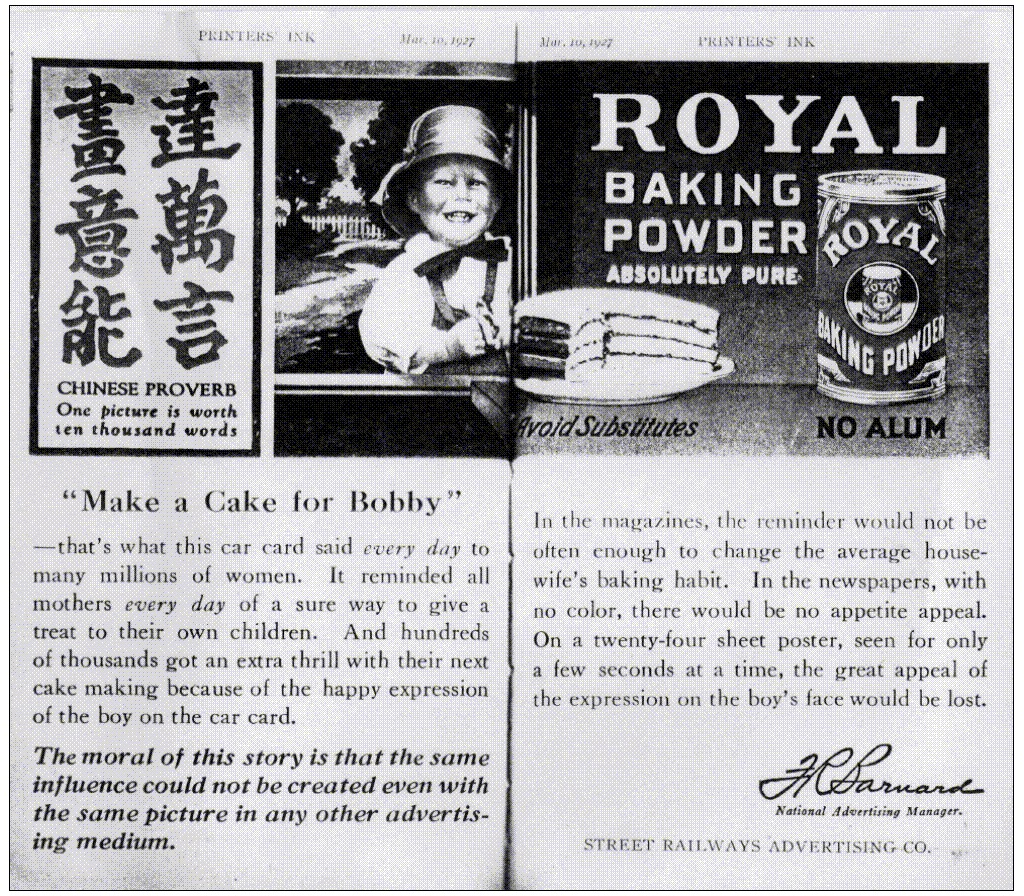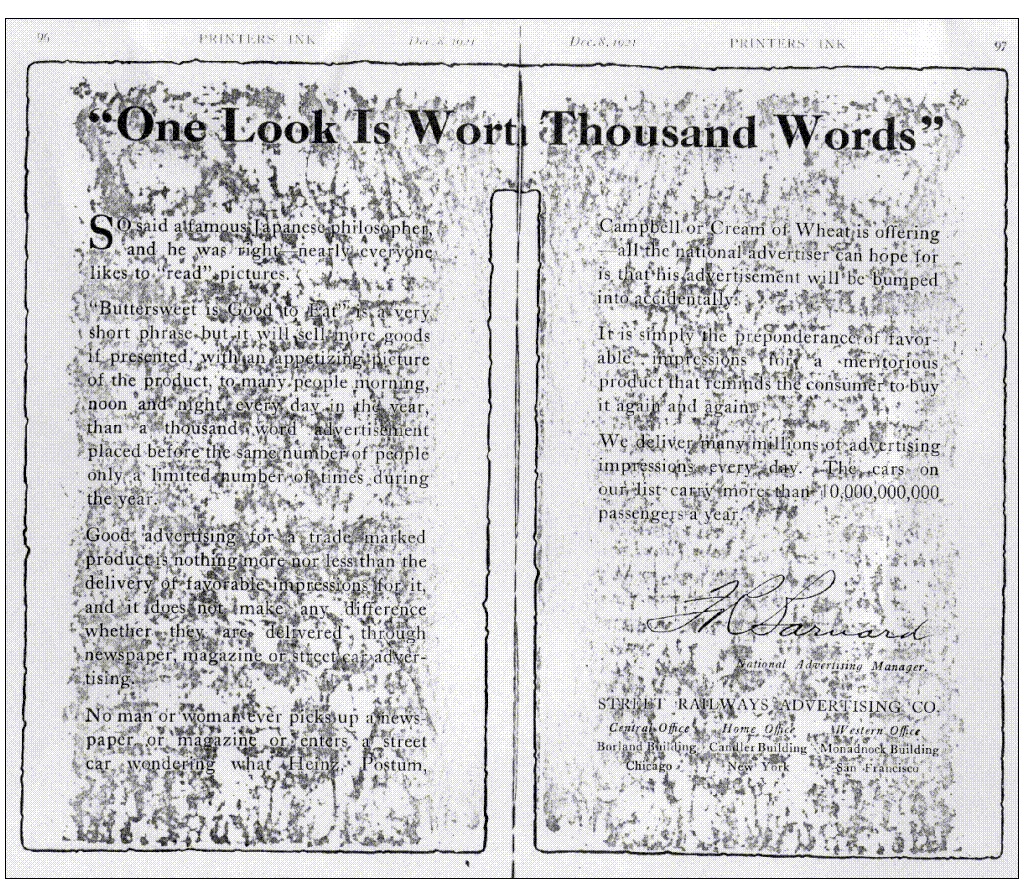A Picture's Worth
A Picture's Worth
What does the phrase “A picture is worth ten thousand words” mean to you? Does it become more or less meaningful if it was written by an advertising executive, a newspaper publisher, or an ancient sage?
I embarked on an exploration into the origins of this phrase in 1999 as part of my doctoral work ( A New Paradigm for Exploration in Computer-Aided Visualization ).
It was important for me to use the phrase correctly and so I wanted to know whether a picture was worth 1,000 or 10,000 words.
Various versions of the phrase, and stories about its origin, are in circulation. This page seeks to trace its history.
For their help with the original version of the page, I thank Dona Bubelis of the Seattle Public Library, Ellen Chamberlain of the University of South Carolina, and Dr. Paul Lester of California State University Fullerton ( A Picture's Worth a Thousand Words? ).
In 1999, credit for the phrase seemed to belong to Frederick R. Barnard, National Advertising Manager for the Street Railways Advertising Company (offices then in New York, Chicago, and San Francisco). The maxim which is popular today seemed to originate as “One look is worth a thousand words”, and appeared in a 1921 advertisement by Barnard. He chose to modify the saying for a 1927 advertisement, where it took on its more famous form. The two advertisements appeared in the advertising trade journal called Printers' Ink (now known as Marketing/Communications).
-
March 10, 1927 (pp. 114-115)
“One Picture is Worth Ten Thousand Words”.
This advertisement uses the specific example of a baking soda ad
campaign seemingly done by Barnard's firm.
The basic message is the same as the earlier ad,
though perhaps Barnard hoped it would be more compelling
as a Chinese proverb.

-
December 8, 1921 (pp. 96-97)
“One Look is Worth A Thousand Words”.
This advertisement talks generally about the benefits about advertising with
pictures on street cars.

Confusion between whether a picture is worth 1,000 or 10,000 words may stem from a 1948 entry in The MacMillan Book of Proverbs, Maxims and Famous Phrases ( formerly known as the The Home Book of Proverbs, Maxims, and Familiar Phrases ) is an early and very informative source about the phrase. Editor Burton Egbert Stevenson made the following entry on page 2611 of that volume:
One look is worth a thousand words. Fred R. Barnard, in Printers' Ink, 8 Dec., 1921, p. 96. He changed it to “One picture is worth a thousand words” in Printers' Ink, 10 March 1927, p. 114, and called it “a Chinese proverb”, so that people would take it seriously. It was immediately credited to Confucious.
This entry establishes the link between the two advertisements, but this source misquotes the 1927 advertisement and thereby creates “One picture is worth a thousand words”.
Familiar Quotations: a collection of passages, phrases, and proverbs traced to their sources in ancient and modern literature by John Bartlett also provides information. Stevenson’s error is repeated on page 782 of the 16th edition (edited by Justin Kaplan and published by Little, Brown in 1992) where it credits “One picture is worth a thousand words” as a misattributed “Chinese proverb” and references part of the entry from the 1948 edition edited by Stevenson.
“Nice guys finish seventh”: false phrases, spurious sayings, and familiar misquotations by Ralph Keyes and published in 1992 by HarperCollins has a similar account to that of Stephenson. Keyes, however, adds his own twists to the story because the phrase “One picture is worth a thousand words” does not appear anywhere in the 1921 ad:
Calling an orphan saying a Chinese proverb gives it a cachet with very little risk that its actual source will be discovered. A deliberate exploitation of this syndrome involved the proverb `One picture is worth a thousand words.' This saying first appeared in a 1921 ad in Printer's Ink [sic] which was written by publicist Frederick Barnard. Barnard headlined his ad `One look is worth a thousand words.' He attributed this maxim to `a famous Japanese philosopher.' Six years later, Barnard revised the saying to read `One picture is worth ten thousand words,' and then republished it in the same magazine as a `Chinese proverb.' Barnard thought his ploy would give his words added weight. He was right. For a time, Bartlett's identified Barnard's line as `a Chinese proverb.' Other sources attributed his proverb to Confucius. The Macmillan Dictionary of Quotations had it both ways. They cited Barnard as the maxim's author, adding `Ascribed to Chinese origin.'
Keyes’ book identified several rules of misquotation and the one of which he and several others have been guilty he calls numbernesia: getting the words right but the numbers wrong.
The Oxford Dictionary of Phrase, Saying, and Quotation is one reference which has the correct attribution (but without any of the story).
The phrase has endured to become an American proverb, appearing on page 465 of A Dictionary of American Proverbs, edited by Mieder, Kingsbury, and Harder and published by the Oxford University Press in 1992.
Current opinion would remove Mr. Barnard from the picture (pun intended). There is now a wikipedia article entitled “A picture is worth a thousand words” that is focused much more broadly than this page.
In updating this page, I came across a wonderful account of the history of this expression written by William Safire for his column On Language for the New York Times Magazine. Worth a Thousand Words was published on 7 April 1996.
If you have more information about the origins of this quotation (or the stories that surround it), please send me e-mail and I will update this page accordingly.
Sources
What does the phrase “A picture is worth ten thousand words” mean to you? Does it become more or less meaningful if it was written by an advertising executive, a newspaper publisher, or an ancient sage?
I embarked on an exploration into the origins of this phrase in 1999 as part of my doctoral work ( A New Paradigm for Exploration in Computer-Aided Visualization ).
It was important for me to use the phrase correctly and so I wanted to know whether a picture was worth 1,000 or 10,000 words.
Various versions of the phrase, and stories about its origin, are in circulation. This page seeks to trace its history.
For their help with the original version of the page, I thank Dona Bubelis of the Seattle Public Library, Ellen Chamberlain of the University of South Carolina, and Dr. Paul Lester of California State University Fullerton ( A Picture’s Worth a Thousand Words?).
In 1999, credit for the phrase seemed to belong to Frederick R. Barnard, National Advertising Manager for the Street Railways Advertising Company (offices then in New York, Chicago, and San Francisco). The maxim which is popular today seemed to originate as “One look is worth a thousand words”, and appeared in a 1921 advertisement by Barnard. He chose to modify the saying for a 1927 advertisement, where it took on its more famous form. The two advertisements appeared in the advertising trade journal called Printers’ Ink (now known as Marketing/Communications).
-
March 10, 1927 (pp. 114-115)
“One Picture is Worth Ten Thousand Words”.
This advertisement uses the specific example of a baking soda ad
campaign seemingly done by Barnard's firm.
The basic message is the same as the earlier ad,
though perhaps Barnard hoped it would be more compelling
as a Chinese proverb.

-
December 8, 1921 (pp. 96-97)
“One Look is Worth A Thousand Words”.
This advertisement talks generally about the benefits about advertising with
pictures on street cars.

Confusion between whether a picture is worth 1,000 or 10,000 words may stem from a 1948 entry in The MacMillan Book of Proverbs, Maxims and Famous Phrases ( formerly known as the The Home Book of Proverbs, Maxims, and Familiar Phrases ) is an early and very informative source about the phrase. Editor Burton Egbert Stevenson made the following entry on page 2611 of that volume:
One look is worth a thousand words. Fred R. Barnard, in Printers' Ink, 8 Dec., 1921, p. 96. He changed it to “One picture is worth a thousand words” in Printers' Ink, 10 March 1927, p. 114, and called it “a Chinese proverb”, so that people would take it seriously. It was immediately credited to Confucious.
This entry establishes the link between the two advertisements, but this source misquotes the 1927 advertisement and thereby creates “One picture is worth a thousand words”.
Familiar Quotations: a collection of passages, phrases, and proverbs traced to their sources in ancient and modern literature by John Bartlett also provides information. Stevenson’s error is repeated on page 782 of the 16th edition (edited by Justin Kaplan and published by Little, Brown in 1992) where it credits “One picture is worth a thousand words” as a misattributed “Chinese proverb” and references part of the entry from the 1948 edition edited by Stevenson.
“Nice guys finish seventh”: false phrases, spurious sayings, and familiar misquotations by Ralph Keyes and published in 1992 by HarperCollins has a similar account to that of Stephenson. Keyes, however, adds his own twists to the story because the phrase “One picture is worth a thousand words” does not appear anywhere in the 1921 ad:
Calling an orphan saying a Chinese proverb gives it a cachet with very little risk that its actual source will be discovered. A deliberate exploitation of this syndrome involved the proverb `One picture is worth a thousand words.' This saying first appeared in a 1921 ad in Printer's Ink [sic] which was written by publicist Frederick Barnard. Barnard headlined his ad `One look is worth a thousand words.' He attributed this maxim to `a famous Japanese philosopher.' Six years later, Barnard revised the saying to read `One picture is worth ten thousand words,' and then republished it in the same magazine as a `Chinese proverb.' Barnard thought his ploy would give his words added weight. He was right. For a time, Bartlett's identified Barnard's line as `a Chinese proverb.' Other sources attributed his proverb to Confucius. The Macmillan Dictionary of Quotations had it both ways. They cited Barnard as the maxim's author, adding `Ascribed to Chinese origin.'
Keyes’ book identified several rules of misquotation and the one of which he and several others have been guilty he calls numbernesia: getting the words right but the numbers wrong.
The Oxford Dictionary of Phrase, Saying, and Quotation is one reference which has the correct attribution (but without any of the story).
The phrase has endured to become an American proverb, appearing on page 465 of A Dictionary of American Proverbs, edited by Mieder, Kingsbury, and Harder and published by the Oxford University Press in 1992.
Current opinion would remove Mr. Barnard from the picture (pun intended). There is now a wikipedia article entitled “A picture is worth a thousand words” that is focused much more broadly than this page.
In updating this page, I came across a wonderful account of the history of this expression written by William Safire for his column On Language for the New York Times Magazine. Worth a Thousand Words was published on 7 April 1996.
Most recently is this post by Garson O’Toole at https://quoteinvestigator.com/2022/07/22/picture-words/.
If you have more information about the origins of this quotation (or the stories that surround it), please send me e-mail and I will update this page accordingly.